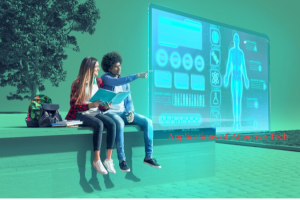
Introduction to Attentive Tech
In today’s fast-paced digital landscape, technology has become integral to our daily lives, shaping how we work, communicate, and interact with the world around us. Among the latest advancements gaining significant traction is attentive tech, a revolutionary concept focused on creating responsive and adaptive technologies to user needs and behaviors. Careful technology encompasses diverse systems and devices with sophisticated sensors, algorithms, and AI capabilities. These technologies are created to observe, interpret, and respond to user actions, preferences, and emotions in real time, providing a seamless and personalized user experience.
At its core, attentive tech seeks to bridge the gap between humans and machines, offering intuitive interfaces and anticipatory services that anticipate and cater to individual needs. Whether it’s an intelligent assistant that learns your preferences over time or a wearable device that tracks your activity and provides timely feedback, attentive technology aims to enhance user satisfaction, engagement, and productivity.

Understanding Attentive Technology
Understanding Attentive Technology involves grasping its core principles of responsiveness and adaptability. This cutting-edge concept utilizes sensors, algorithms, and AI to observe and interpret user actions, preferences, and emotions in real time. By analyzing data, attentive tech can tailor responses and functionalities to individual needs, providing a seamless and personalized user experience. This technology aims to bridge the gap between humans and machines, offering intuitive interfaces and anticipatory services. Whether through intelligent assistants or wearable devices, attentive tech enhances user satisfaction and engagement by effectively anticipating and meeting individual needs.
Benefits of Attentive Tech
Enhancing User Experience
Attentive tech aims to revolutionize user experience by offering personalized interactions and anticipatory services. From intelligent assistants that learn user preferences to intuitive interfaces that adapt to individual behaviors, attentive technology enhances user satisfaction and engagement.
Improving Productivity
Improving productivity is a central goal of attentive technology, offering numerous benefits across various industries and workplaces. One of the primary ways focused technology enhances productivity is by automating repetitive tasks and streamlining workflows. By leveraging algorithms and AI capabilities, alert systems can analyze patterns and trends in data, identify inefficiencies, and suggest optimizations to simplify processes. This automation frees up time and resources for employees to focus on more strategic tasks, ultimately boosting overall productivity and efficiency.
Personalized Interactions
One of the significant advantages of attentive tech is its ability to deliver personalized interactions across various touchpoints. Whether in customer service, marketing campaigns, or educational platforms, these technologies tailor content and recommendations based on individual preferences and past interactions, fostering stronger connections and loyalty.
Applications of Attentive Tech
Attentive technology finds applications across diverse sectors, revolutionizing how we interact with technology and each other.
Healthcare
In healthcare, attentive tech enhances patient care by monitoring vital signs, detecting anomalies, and providing timely interventions. Wearable devices and remote monitoring systems equipped with focused capabilities enable healthcare providers to deliver proactive and personalized care, ultimately improving patient outcomes.
Education
In education, attentive technology holds immense promise for transforming learning experiences and improving student and educator outcomes. One of the critical advantages of focused technology in education is its ability to provide personalized learning experiences tailored to individual students’ needs and preferences. Attentive technology can adapt instructional content, pacing, and delivery methods to optimize learning outcomes by analyzing data on students’ learning styles, preferences, and performance. This personalized approach helps students stay engaged and motivated, leading to better retention and mastery of concepts.
Customer Service
Attentive tech revolutionizes customer service by offering proactive assistance and personalized recommendations. Virtual agents and chatbots with focused capabilities anticipate customer queries and preferences, delivering timely and relevant solutions and enhancing satisfaction and loyalty.
Marketing
In marketing, attentive technology offers unprecedented opportunities to create more personalized and effective campaigns. By leveraging data analytics and AI capabilities, marketers can gain deeper insights into consumer behavior and preferences, enabling them to tailor their strategies and messages to specific audience segments.
One of the critical advantages of at in marketing is the ability to deliver highly targeted and relevant content to consumers. Marketers can identify individual preferences and interests by analyzing user interactions and engagement patterns, allowing them to serve personalized ads and recommendations that resonate with their target audience.

Challenges and Limitations
Attentive technology presents several challenges and limitations that must be addressed to ensure its successful implementation and adoption. Privacy concerns are one of the primary challenges associated with focused technology. The collection and analysis of vast amounts of user data raise concerns about the privacy and security of personal information. Users may feel uncomfortable with the level of surveillance required for at technologies to function effectively, leading to potential resistance or backlash against these technologies.
Privacy Concerns
Collecting and analyzing vast amounts of user data raises concerns about privacy and protection. Users may feel uncomfortable with the level of surveillance required for technologies to function effectively, necessitating transparent policies and robust security measures to safeguard sensitive information.
Data Security
Data security is a critical aspect of attentive technology implementation. With the collection and analysis of vast amounts of user data, ensuring this information’s confidentiality, integrity, and availability is paramount. Robust data security measures must be in place to protect sensitive data from unauthorized access, breaches, or misuse. Encryption techniques are crucial in safeguarding data in transit and at rest. Encrypting data becomes unreadable to everyone with the proper decryption key, minimizing the risk of data interception or theft. Additionally, Installation of access controls is necessary. Into practice. To restrict access to sensitive data only to authorized personnel.
Ethical Considerations
The use of at raises ethical questions regarding autonomy, consent, and bias. Developers must navigate complex ethical dilemmas related to data ownership, algorithmic transparency, and fairness to ensure that attentive technologies serve the interests of users and society.
Future Trends in Attentive Tech
Future Trends in At hold exciting possibilities for further enhancing user experiences. Advancements in emotion recognition, context-aware computing, and neuroadaptive interfaces are poised to revolutionize how we interact with technology. Emotion recognition technologies will enable devices to perceive and respond to users’ emotional states, fostering more empathetic and intuitive interactions. Context-aware computing will allow systems to understand the user’s environment and adjust their behavior accordingly, offering personalized assistance tailored to specific situations.
Conclusion
In conclusion, at heralds a new era of technology-driven experiences marked by responsiveness, personalization, and adaptability. As we navigate the digital landscape, integrating sensors, algorithms, and AI capabilities into everyday devices and systems offers unparalleled opportunities to enhance user interactions and streamline processes across various domains. However, amidst the excitement of innovation, it’s crucial to acknowledge and address the challenges accompanying at. Privacy concerns, data security risks, and ethical considerations loom, demanding careful attention and robust measures to safeguard user rights and values.
Despite these challenges, the potential of at is vast and promising. From revolutionizing healthcare and education to transforming customer service and marketing, focused technologies hold the power to reshape industries and elevate user experiences to new heights.
FAQs
How does attentive tech differ from traditional technology?
AT goes beyond traditional technology by actively observing and adapting to user behaviors and preferences in real time, offering personalized experiences and anticipatory services.
Are there any privacy risks associated with attentive tech?
The collection and analysis of user data raise privacy concerns, necessitating robust security measures and transparent policies to protect sensitive information.
Can attentive tech improve customer service experiences?
Absolutely. AT enables proactive assistance and personalized recommendations, enhancing customer satisfaction and loyalty.
What are some future trends in attentive tech?
Future trends include emotion recognition, context-aware computing, and neuroadaptive interfaces, which promise to enhance the capabilities of attentive technologies further.
How can businesses leverage attentive tech in marketing campaigns?
Businesses can tailor content, offers, and recommendations to specific audience segments by analyzing consumer behavior and preferences, driving engagement and conversion rates.

Leave a Reply